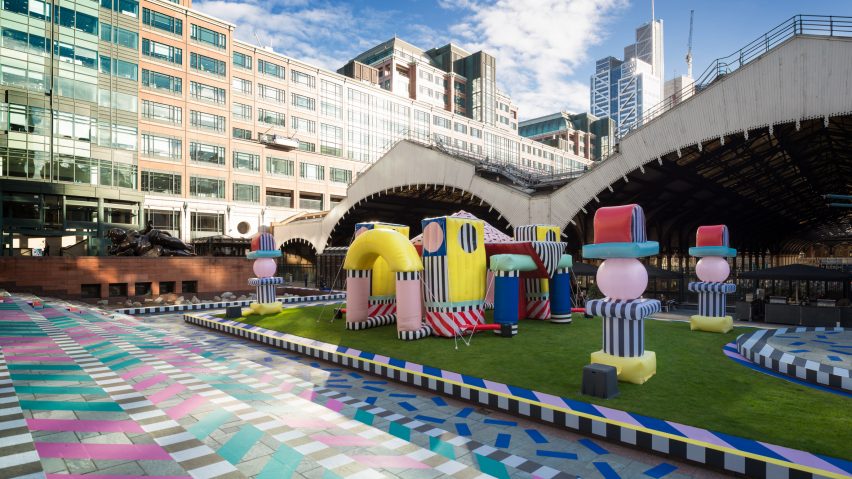London Design Festival has claimed record visitor figures for 2017, but admitted it counted every person who visited participating museums and passed through public squares hosting installations.
The festival issued a press release saying it welcomed an estimated 419,799 individual visitors between 16 and 24 September, and had 930,773 visits overall. Twenty-four per cent of these were overseas visitors, it said.
An LDF spokesperson said that all previous attendance records were broken in 2017, the festival's fifteenth year. "They are all record breaking [figures] which is fantastic!" the spokesperson said. "Busiest weekend, busiest day and busiest week!"
However the spokesperson admitted that the figures included everyone who entered the V&A museum, and everyone who visited venues including Somerset House and the Design Museum during the festival period.
The figures also included everyone who passed through Exchange Square next to Liverpool Street Station. The square, part of the bustling Broadgate office development, hosted Villa Walala, an inflatable installation by graphic designer Camille Walala during the festival.
The festival's press release claimed that "150,000 people passing through Broadgate each day had the opportunity to see Villa Walala".
When pressed on the figures by Dezeen, the festival spokesperson admitted: "We only have the overall Broadgate [visitor] count so have to term this as an opportunity to see. We can't directly correlate this as a direct engagement/visit to Villa Walala."
The festival also claimed it "helped drive a total of 173,250 visits to the V&A".
It admitted that it counted every single visitor to the giant west London museum as a festival visitor, even though data showed that only 22 per cent of visitors during the period attended as a direct result of festival activities.
Global Design Forum, an LDF conference held at the V&A, attracted 2,800 visitors, a 68 per cent increase on last year.
The V&A was a key venue for LDF activities, hosting the Reflection Room installation by Flynn Talbot and several other exhibits specially programmed for the festival. But the museum also hosted shows unrelated to the festival, including a blockbuster six-month show about rock group Pink Floyd and an exhibition about the history of plywood that ran all summer.
"So whether a visitor is coming to [the] Pink Floyd [exhibition] for example or to Reflection Room this is all within this stat," the spokesperson said.
This summer also saw the opening of Exhibition Road Quarter, a major new wing of the museum designed by architect Amanda Levete.
When Dezeen contacted the V&A to ask about visitor figures during the period, a spokesperson said that it had experienced record visitors over the summer but made no mention of the festival's impact.
"The V&A welcomed record visitors over the summer 2017, with July, August and September the most successful months in the history of the V&A," the spokesperson said. "Visitors came to experience our popular exhibitions from Pink Floyd to Plywood, and to the V&A's new Exhibition Road Quarter, brought alive by the REVEAL festival this summer."
As part of its record visitor total the festival also counted almost 80,000 people who visited Somerset House, a historic building in central London built around a large publicly accessible courtyard. The courtyard hosted Pentatonic, a festival installation, while part of the building was used as the venue for an exhibition called Design Frontiers. But the complex also contains restaurants, offices and other facilities.
The festival's press release said that "77,160 visitors welcomed to Somerset House across the seven days had the opportunity to see Pentatonic in the Courtyard."
When asked if the festival counted every single person who visited Somerset House as a festival visitor, the spokesperson said: "Yes correct". The 16,500 people who attended the Design Frontiers exhibition at Somerset House were also counted.
Other visitor figures the festival added to its overall attendance figures include the 106,000 people who visited five "Design Destinations" around the city. The spokesperson said the figures were calculated by adding up visitors to each destination and could not rule out the possibility that the same people were being counted more than once.
"This is a total of all five Destinations visitors," said the spokesperson. "It is not a unique figure so it is total visitor numbers."
Finally, the festival's press release included 19,500 people who visited the Design Museum during the week to visit festival-related exhibitions as well as permanent shows and the museum's free-to-visit atrium.
When asked whether it was counting every single Design Museum visitor as an LDF visitor, the spokesperson said: "Yes correct."
The festival spokesperson also supplied a statement from The Audience Agency, the research company that compiled the visitor figures, explaining the methodology used.
"Throughout this report, figures for both visits and visitors are given," The Audience Agency wrote. "A visit is defined as an engagement with an element of the Festival's programme, for instance attending a product lunch, visiting designjunction, or seeing a Landmark Project. An individual may visit multiple events."
"We asked each partner to tell us how many visitors they had at their event(s) and combined these numbers to come up with a figure for the total number of visits made to Festival events. 'Visitors' describes the number of individuals who engaged with the Festival one or more times."
"Whilst it is not possible to track visitors from one event to the next, we can estimate the number of visitors by dividing the total number of visits (from the Partner survey) by the average number of visits made by each respondent to the audience survey."
London Design Festival was established in 2003 by John Sorrell and Ben Evans. The 2017 event was the third most popular design week of the year according to Dezeen Hot List 2017, behind Milan design week and Dutch Design Week.

